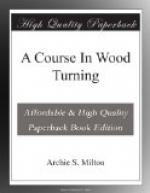Slowly draw the chisel back and at the same time raise the handle until the chisel begins to cut about 1/4” to 3/8” from the heel. The first cut is begun from 1” to 2” from either end and is pushed toward the near end. Then begin at the first starting point and cut toward the other end. One should never start at the end to make a cut as there is danger that the chisel will catch and cause the wood to split or that the chisel will be torn from the hands.
The first cut takes off the bumps and rings left by the gouge, and takes the stock down so one can just see where the scraping to size was done. Then take the last cut and remove all traces of these, leaving the cylinder perfectly smooth and of the required diameter at each end. Test the cylinder for accuracy with a straight edge.
[Illustration: Fig. 6.]
4. Testing for smoothness. In testing for smoothness place the palm of the hand, with the fingers extended straight, lightly on the back of the cylinder opposite the tool rest. This position will avoid any possibility of the hand being drawn in between the cylinder and the rest.
[Illustration: Fig. 7.]
5. Measuring for length (rule and pencil). Fig. 7. Hold the back edge of the rule in the left hand and place it on the tool rest so that the front edge is almost in contact with the revolving cylinder.
With a sharp pencil mark off the required length, starting from the dead center end. The first mark should be just far enough in on the cylinder to insure cutting past the point of the dead center. This will leave all surplus stock at the live center end where it is needed, because, if not enough stock is left at this end, there is danger of striking the live center spur with the tool and of injuring the chisel and perhaps the work.
In case several measurements are to be made, as in some of the following exercises, the rule should not be moved until all are marked. This will insure more accurate work than if the rule be changed several times.
6. Squaring ends (small skew and parting tool). Fig. 8. This operation is done with the toe or acute angle of the 1/2” or 1/4” skew chisel.
Place the chisel square on the tool rest. Swing the handle out from the cylinder so that the grind, which forms the cutting edge, next to the stock is perpendicular to the axis of the cylinder. The heel of the chisel is then tipped slightly from the cylinder in order to give clearness. Raise the handle and push the toe of the chisel into the stock about 1/8” outside the line indicating the end of the cylinder. Swing the handle still farther from the cylinder and cut a half V. This will give clearance for the chisel point and will prevent burning. Continue this operation on both ends until the cylinder is cut to about 3/16” in diameter.




